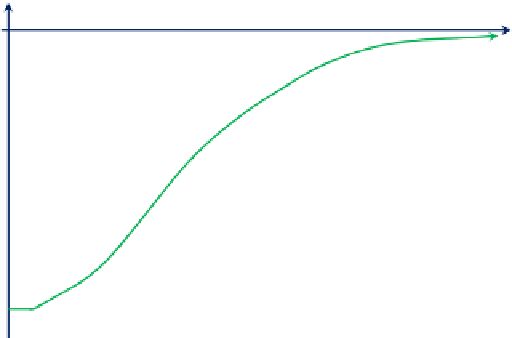Biomedical Engineering Reference
In-Depth Information
indirectly affects the carbon emission scheme. On top of the confusion in splitting the source
energy (or intended source of energy) used in production, processing, and transportation of
the biomass fuel, there is still the net CO
2
emission in atmosphere.
Fossil energy source has higher energy density of available energy output per unit mass
(and other known pollutant gases due to the composition of biomass). On the per carbon
basis, however, the available energy output is similar to coal at room temperature (from
energy regularity in section
3.9) although still lower than hydrocarbons because of the
oxygen (and hydrogen) content. When burning woody biomass and releasing effluent gas
at high temperatures, the energy efficiency is reduced due to the extra water content resulted
from the oxygen and hydrogen in woody biomass. Utilization of woody biomass for energy
releases more CO
2
and H
2
O into atmosphere than fossil use. Switching from fossil energy to
woody biomass energy can thus cause a shift to higher CO
2
emission into atmosphere than
continuing using fossil fuel. This phenomenon has fooled some people into believing woody
biomass is worse than fossil energy source for the environment. In a short term (
x
32 years)
after utilizing woody biomass, there is an increased amount of GHG over fossil fuel utiliza-
tion as depicted by
Fig. 15.12
. The transition from fossil economy to woody biomass economy
requires thus in excess of 32 years before seeing the same level of CO
2
in atmosphere.
In a sustainable or steady manner, renewable forest material is carbon neutral, i.e. utilizing
forest material will not create a carbon imbalance over the life cycle of the forest, which is an
extended 5
e
80-year time for managed forests as shown in
Table 15.4
.“Catch and Release”is
the key in biomass utilization. Carbon dioxide is drawn from the atmosphere for plants to
grow, while planting, management, conversion of biomass to bio-products, utilization and
decomposition of bio-products will all produce carbon dioxide. In an optimal balanced
operation, carbon dioxide is simply recycled during the life span of plant growth and
<
Time, year
10
20
30
40
50
60
70
80
90
100
0
-10 Mg-CO
2
Incremental CO
2
sequestration
by forest after increasing the
amount of biomass harvested
-5
-20
-30
-10
-40
CO
2
released from burning fossil fuel
-50
-15
-60
-70
-20
CO
2
released from burning forest biomass
-80
FIGURE 15.12
A schematic of incremental carbon storage after an extra 20 Mg-C (or 73.28 Mg-CO
2
) harvested
on the same stand above a traditional harvest (Redrawn based on Walker T, Cardellichio P, Colnes A, Gunn J, Kittler
B, Perschel B, Recchia C, Saah D, “Biomass Sustainability and Carbon Policy Study”, Commonwealth of Massa-
chusetts Department of Energy Resources and Manomet Center for Conservation Sciences, June 2010.).








































Search WWH ::

Custom Search